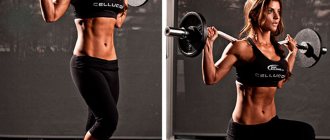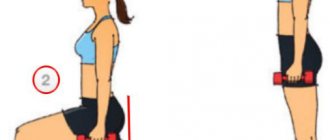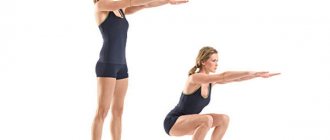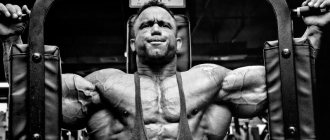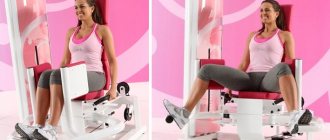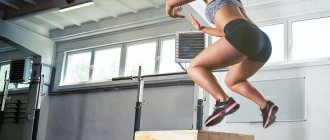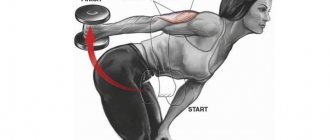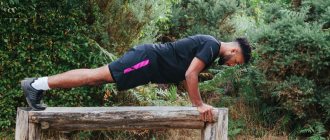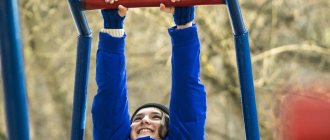The benefits of lunges
The popularity of the exercise is due to many advantages:
- Development of power characteristics . Lunges with additional weights are used in strength training as a way to specifically target the hips.
- Relief improvement . Quick lunges with your own weight or minimal loads help to achieve high-quality “detailing” of the leg muscles.
- Development of coordination . Thanks to the simultaneous development of several stabilizer muscles, the athlete improves his sense of balance and dexterity.
- Strengthening problem areas . Girls use lunges to work their inner thighs, improving the appearance of their legs.
- Losing weight . The exercise simultaneously uses large muscles of the body, which forces the body to spend a large number of calories to provide energy.
- Butt training . By changing the exercise technique, an athlete can shift the emphasis of the load from the hips to the buttocks, achieving an increase in their volume.
- Stretching . Thanks to deep lunges in different directions, the athlete gets the opportunity to improve leg stretching and hip joint mobility.
In addition to the above, classic lunges with your own weight can be an excellent replacement for squats with a barbell if you have problems with the spine.
Benefits of exercise
The lunge exercise with dumbbells, in addition to being highly effective in working the gluteal muscles and thighs, has the following advantages:
- During the training process, the muscles are not only loaded, but also stretched.
- Despite the weights, lunges, unlike squats, place less stress on the spine.
- Possibility to train at home.
Lunges with dumbbells for girls will allow you to get a beautiful elastic butt and toned hips. In addition, the training improves flexibility, develops a sense of balance, and straightens posture. When choosing dumbbells, girls should not purchase them weighing more than fifteen kilograms. A wider step when lunging will allow you to intensify the work and achieve maximum effect.
Lunges with dumbbells for men will give them a sculpted body. Due to dumbbells with high weights and intense speed of performing the element, fat is burned. A technique based on intense lifting and smooth squatting will allow you to increase your leg muscles.
Lunges forward and backward
The most popular variation of the exercise is the classic forward lunge. They are used by both professional athletes and beginners. Technique:
- We stand up straight and press our hands to our belts.
- Inhale, step forward and simultaneously lower your pelvis.
- In the lower position, the knee joints of both legs should be at an angle of 90°.
- We hold for a couple of seconds, and then, with an exhalation, we also smoothly return to the vertical position.
- We repeat the exercise starting with the other leg.
At first you will be a little wobbly. Therefore, until the muscles become stronger, perform lunges without additional weights.
If you have difficulty maintaining your balance, we recommend using a Smith machine. The lunge technique in this machine is as follows:
- We stand in the machine, remove the sliding bar from the stops and press it against the trapezius muscle (upper back).
- We put one leg forward and take the other back. The distance between the feet should be approximately 60–70 cm.
- Inhaling, we smoothly lower ourselves to a right angle at the “front” knee.
- We hold for a couple of seconds, and then, exhaling, we also smoothly return to the starting position.
- We do 10-12 squats, change legs and repeat.
The bar is secured to the rails so you can squat safely into a lunge while strengthening your thigh muscles.
If you experience pain in the knee joint, replace classic lunges with reverse lunges. The only difference is in the technique: the leg is not moved forward, but backward.
Once you have mastered simple and reverse lunges without weight, gradually add weights. Start with light dumbbells in each hand (2-3 kg) or small weights. If you are confident in your abilities, perform the exercise with an empty bar on your shoulders.
General recommendations for the considered variations:
- do not slouch or round your back;
- do not extend your front knee further than your toes;
- Turn the toe of the “back” leg slightly inward;
- in any variation, do not place the “back” knee on the floor;
- do not lean forward too much;
- keep your head straight;
- If you can’t maintain balance, grab a support with one hand.
Features of the exercise
Lunges with dumbbells are a powerful tool for building beautiful and firm buttocks; also in this exercise the load can be shifted to the quadriceps and hamstrings.
Lunges can be done with dumbbells or with a barbell, but there are no significant differences in technique between these varieties, choose the one that is more convenient for you to perform in your gym.
If you have a good dumbbell row at your disposal, then it will definitely be better to perform this exercise with dumbbells, since it will be more convenient for you to distribute the load and try to increase the working weight in the exercise with each new workout.
What's the point?
Lunges with dumbbells in your hands are alternating steps with a full range of squats on the front leg. The wider we take the step, the more load the buttocks and hamstrings receive; the narrower we take, the more the quadriceps work. This way, you can vary the load between these muscle groups depending on which muscles you want to work in today's workout.
Benefit
The benefits of lunges with dumbbells are undeniable - no amount of leg abductions in a machine or leg lifts while lying on your stomach will give such a positive result. Therefore, lunges are useful for both men who want to gain impressive muscle mass and women whose goal is to build sexy buttocks and charm everyone around them.
Lunges using a platform
First, let's look at the “Bulgarian” lunges. The variation involves the use of a high support for the hind leg. Technique:
- We stand with our backs to the bench.
- Take a wide step with your right foot. The distance between the feet is 70–80 cm.
- Raise your left leg and place its toe in the seat.
- Cross your forearms at chest level.
- As you inhale, smoothly lower your body as low as possible (for beginners, it is acceptable to squat to a right angle at the “front” knee).
- We hold for a second, then, as we exhale, we rise just as smoothly.
By lifting the “back” foot high, the body’s weight is essentially shifted to the “front” foot, which increases the load on the quadriceps, glutes and hamstrings.
Recommendations:
- Press your “working” foot into your heel;
- do not extend your knee further than your foot;
- Having risen, do not straighten the knee joint completely;
- do not rest in the upper phase;
- keep your lower back arched;
- To increase the load, use a fitness ball or TRX loops instead of a solid support.
Now let's look at another option for using platforms. Using a low stand, you can perform wide lunges for the buttocks. The technique is simple:
- We select a low platform (15–20 cm). We take dumbbells in our hands and stand on the stand.
- Keeping your back straight, inhale, move your right leg back as far as possible and place its toe on the floor.
- In the lower phase, we linger for a second, and then, as we exhale, we smoothly return to the starting position.
- Repeat with the left leg.
In this exercise, the muscles of the buttocks work more efficiently than with conventional reverse lunges, since due to the lifting of the supporting foot, the stretching of the entire back surface of the thigh increases.
Recommendations:
- when abducting the “back” leg, keep the “front” shin vertical;
- slightly tilt your body forward, but do not round your back;
- do not perform the element from a high platform (for example, from a bench), it can be dangerous.
Variations
- Dynamic lunges. They are also “stepping lunges,” but this name is less common. They are regular lunges, but with a step back. It is necessary to take the starting position each time. The working leg does not move, only the supporting leg walks;
- Lunges along the width of the step - with a medium width, with a large one and split squats. Accordingly, foot placement affects muscle accents. The split squat works more on the hamstrings, the wide step on the buttocks, and the classic squat on the quadriceps;
- Walking lunges are “walking” across the gym with lunges, that is, stepping, bending your knees and hips, and stepping forward with your supporting leg. For some strange reason, it is believed that this is the best lunge for buttocks, girls, weight loss and advertising fitness training. In fact, it is an exercise for the quadriceps, in most variations.
Lunges with dumbbells (we pump up the buttocks)
Side lunges
The exercise allows you to well load the outer side of the quadriceps and buttocks. In addition, the inner thighs are strengthened and leg stretching is improved. Let's start with a simple technique for beginner athletes:
- We stand up straight and spread our feet wide (80–100 cm). We put our hands on our waists.
- As we inhale, we shift our body weight to the side and move our pelvis back, as if we were sitting down on an imaginary chair.
- As you exhale, we return to the starting position.
- Repeat on the other side.
The exercise can be performed with weights, for example, with a body bar on your shoulders.
Let's look at a slightly more complicated version of side lunges:
- We stand up straight and place our feet the width of our pelvic bones.
- Inhale and take a step to the side.
- At the same time, we move the pelvic region back.
- As you exhale, we return to the vertical position.
- We perform in the opposite direction.
Recommendations for the presented exercise options:
- do not extend the knee joint beyond the foot;
- slightly tilt your body forward;
- at the lowest point, take a slight pause;
- if you want to make it more challenging, hold a dumbbell in each hand or perform side lunges from a step platform.
Why are lunges good?
There are several reasons to include lunges in your workouts. This exercise:
- Works the HAMSTRINGS, QUADRICES, AND GLUTEAL MUSCLE ACTIVATION DURING RESISTANCE TRAINING EXERCISES the gluteal muscles and anterior thighs better than squats and deadlifts.
- Strengthens the stabilizer muscles of the pelvis and core, improves the sense of balance.
- If the correct technique is followed, Muscle activity during leg strengthening exercise using free weights and elastic resistance: Effects of ballistic vs controlled contractions is safe for the knees and can be used during rehabilitation after injuries and surgeries.
- It has many variations, allowing you to shift the focus to different muscle groups and simultaneously pump up the upper body and core muscles.
Cross lunges
The exercise is similar to reverse lunges. The difference is that the leg pulled back “goes” beyond the supporting line. Thanks to this, the muscles of the buttocks are stretched at an unusual angle and are effectively worked out. Technique:
- We stand straight, feet shoulder-width apart.
- Inhale and move the right foot back behind the left.
- At the same time, we lower the pelvis until a parallel is formed between the thigh of the supporting leg and the floor.
- We hold for a second and exhale, returning to the starting position.
- Repeat with the left leg.
For beginner athletes, we recommend a lightweight version of cross lunges:
- We get into the Smith machine.
- We take a straight grip on the bar and press it to the upper back.
- As you inhale, take a deep step back and place your foot behind your supporting leg.
- We lower ourselves to a right angle at the front knee.
- As you exhale, return to the starting position and repeat in the other direction.
Recommendations:
- Place your hands on the bar closer to your shoulders, this will help keep your back arched;
- Keep the shin of the front leg vertical, do not allow the knee to deviate inward.
Emphasis on quadriceps and glutes
If we analyze which muscles work during lunges with dumbbells, we get the following picture:
- The quadriceps (quadriceps muscle of the thigh, occupies its anterior surface) is one of the two main working groups. This muscle extends the leg at the knee joint when we rise from the lowest point.
- The gluteus maximus muscle (makes up the bulk of the buttocks) - along with the quadriceps, experiences significant stress when extending the hip when lifting up.
In addition to the quadriceps and gluteus maximus, the following muscles take part in the work: the abdominal muscles, gluteus medius, hamstrings, back muscles, calf muscles, etc. The main function of the listed muscles in this exercise is to stabilize the position of the body and legs. It’s not for nothing that the movement is called coordination complex - it’s really not always possible to maintain balance the first time. You can also mention the arm muscles with which you hold dumbbells - they work statically.
By varying the width of your step when performing lunges with dumbbells in your hands, you can shift the load towards the buttocks or towards the quadriceps:
- The step is wider, the supporting leg has an angle at the knee of more than 90 degrees - the gluteal muscle stretches better and works more. This is the best option for most girls. However, the wider your feet are, the less comfortable it is to step and walk back.
- The step is narrower, the supporting leg is bent at a right angle - the front surface of the thigh is more involved.
The technique of lunges with dumbbells in hands allows for different step widths, with the only caveat that the legs should not be too close to each other or, conversely, too wide. Too close is when the working leg begins to extend the knee beyond the line of the toe. Too wide is when the supporting leg is almost straight. In a wide position, with good stretching, you can do lunges in place, but not dynamically.
Dynamic lunges
When performing a walking exercise, an athlete spends more calories than with a static technique. This helps get rid of subcutaneous fat. In addition, stabilizer muscles are more actively involved in movement, which improves body balance and coordination.
Let’s look at the technique of “walking” dynamic lunges:
- We stand up straight, put our hands on our belts.
- We take a step forward and lower our thighs until they are parallel to the floor.
- Then we push the body with the “front” foot, rise and immediately take a step with the other leg.
- We move around the hall like this.
To increase the load, you can pick up dumbbells. Recommendations, as in standard lunges:
- do not “fall” forward with your body;
- do not extend your knee further than your foot;
- Don't round your spine.
Now let's look at alternating lunges while jumping. This exercise, by adding plyometric load, allows you to better work your quadriceps. Technique:
- We take the “lunge on the right leg” position.
- With an exhalation, we push the body up and jump.
- In the air, we change the position of our legs and land in a left lunge.
Recommendations:
- Don't lean forward too much.
- Choose the optimal width of your feet. A position that is too narrow will stress the front knee, while a position that is too wide will interfere with balance.
Dynamic lunges also include stepping to the sides with an expander on your feet. This exercise works the gluteal muscles well. Technique:
- Take an expander (mini loops or rubber band) and secure it to your ankles.
- We spread our feet slightly wider than our shoulders. The elastic should be in tension.
- Sit down slightly on your feet and tighten your abdominal muscles.
- We perform short side lunges, holding the expander under tension.
- We move around the hall in this way, for example, 10 steps to the right and 10 to the left.
Recommendations:
- do not let the elastic band loosen;
- walk on your toes.
What muscles work when lunging with dumbbells?
- The target muscle group is the gluteal muscles and quadriceps.
- Also involved in the work as stabilizers are the abdominal muscles, shoulder girdle, lumbar region and calf muscles.
Using lunges in training programs
As a rule, a fitness program is not built on the basis of lunges alone. They are included in the plan after basic strength exercises as a “replenishment” of muscles.
Example of training for terrain
We offer an option for working out the lower body and forming a beautiful leg relief:
- Warm up - 5 minutes of cardio (running, exercise bike, elliptical, jump rope).
- Squats with a barbell on the shoulders - 3x10.
- Leg press in Hack - 3x12.
- Lunges with dumbbells - 3x12.
- Straightening the legs in the simulator while sitting - 3x12.
- Bulgarian lunges - 3x12.
- Bend legs in a lying machine - 3x12.
- Wide lunges from the platform - 3x12.
- Roman chair abdominal curls – 3x15.
If you want to gain muscle mass, increase the weight in the basic elements (squat and leg press) and reduce the number of repetitions to 8. Do additional exercises for 10–12 repetitions.
Example of a weight loss workout
Lunges are also used in weight loss programs:
- Warm up: 10 minutes of cardio.
- Quick squats with an empty bar - 3x15.
- Classic lunges - 3x15.
- Jumping out of a deep squat - 3x15.
- Side lunges - 3x15.
- Lunges with jumping and stepping - 3x15.
- Leg swings with weights - 3x15.
- Stepping onto a platform with dumbbells - 3x15.
- Crunches on the floor - 3x15.
We recommend combining weight loss workouts with cardio exercises (running, cycling, swimming, aerobics).
Avoiding injuries
Lunges with dumbbells, like any other type of lunge, place increased stress on the ligaments of the knee joints. In this regard, they are more dangerous than, say, squats. This is explained by the fact that during squats, the weight of the body and weights are distributed on two legs, and when doing lunges, you focus the entire load on one leg. Of course, the muscles are delighted with this, but weak ligaments may suffer.
Therefore, to prevent injury, use the following recommendations:
- Avoid lunging with dumbbells if you have a recent knee injury. If there were injuries, but for a long time, do the exercise extremely carefully and stop if the slightest discomfort occurs. Health, you understand, is more expensive.
- Before you start training, you need to warm up the muscles and provoke the release of joint lubrication (synovial fluid). To do this, we squat and do lunges without weights, rotate our feet and shins, bend forward, etc. It will take five minutes, but the effect of the workout will be much higher, and the likelihood of getting injured is lower.
- When working with heavy weights, do not take steps. That is, both legs remain in place and your dumbbell lunges automatically transform into scissor squats.
- If you have not practiced lunges before, practice the technique without weight first.
- If pain, discomfort or any other signals occur that should not normally exist, stop the exercise.
If, due to problem knee joints, lunges are not suitable for you, then you can try replacing this exercise by abducting your legs (swings) while standing back, forward, or to the sides. This can be done in a special simulator or on a lower block. To work the buttocks, lunges can be replaced with a gluteal bridge. But, since every injury is individual, there are no universal recommendations, and therefore it is better to consult a doctor.
Actually, let's move on to a description of how to do lunges correctly.
Comparison of lunges with squats
The lunge technique is based on shifting the body weight onto one leg, which allows you to use stabilizers and place an emphasis on the hips and buttocks. But, since the exercise is performed essentially with one leg, it will not be possible to take a lot of weight in your hands or on your shoulders. Therefore, even power lunges will not help increase overall body weight.
Another thing is squats. They are performed with equal support on both feet, which allows you to gradually increase the load. Thanks to this, power squats stimulate the production of hormones responsible for muscle growth throughout the body.
We recommend combining both exercises in one training session. Squats - to increase strength and increase overall body weight, lunges - to work out the relief of the hips and buttocks.
Forward lunges with alternating legs
Forward lunges
It looks roughly the same as the classic version, only we lunge with each leg in turn and return them to the starting position. This exercise puts a little more stress on the front of the thigh. This happens when the leg returns to its original position. To do this, we will need to take the body a little back. And push off the floor with your supporting leg. With this position of the body, it is more difficult to load the gluteal muscles, since they are in a compressed state. This means they will bear a smaller share of the load. In my opinion, these attacks have several disadvantages:
- The exercise requires a lot of time to complete. Since there is a constant alternation of legs with a return to a standing position. This option will take twice as long to complete. If you don’t have it, then this lunge option is not for you.
- Floating load . When we lunge, for example, with our right leg, we load the gluteal region and thigh of that side. And when returning to its original position, it disappears. And now until we do a repetition on the left side, the right one will not be used.
Of course, there is an opinion that during drying this option is more suitable. Since much more energy is spent on its implementation. This in turn burns more calories.
Lunges with alternating legs backwards (reverse lunges).
But here things are a little different than with forward lunges. We will step back and then return the leg to its original position. The main problem will be that we cannot see where we are placing our feet, so it will be difficult for inexperienced athletes to maintain balance. Unlike the previous option, when returning to the starting position we will have to tilt the body a little forward. This means that the gluteal muscles will stretch more and most of the load will be transferred to them. So if your goal is to develop the buttocks, then it is better to use this option. The disadvantages are the same: it takes more time to complete the exercise and there is no constant load on the muscles. Personally, I have never seen this option performed by men, but girls do it often.
Cross lunges back
This is a more complex variation of the reverse lunge. To perform it, you need a good stretch of the knee and hip joints. This version is reminiscent of the “Curtsey” style greeting. That is, we will not move the back leg in a straight line, but will lead it behind the one in front. Of course, you will have to significantly reduce the weight of the burden. Since there is a very high risk of injuring the knee. All because of their unnatural bending (slightly at an angle). But why do we even need to lunge at an intersection? Of course, in order to further stretch the gluteal region. This will lead to their greater involvement in work. This option is also recommended for the fair sex. But before you pick up dumbbells, you should do some stretching. And also practice the technique in regular lunges with a step back. And only then start performing crossovers.
Passing lunges
This is also a very common option. It is performed with dumbbells or a barbell. I think it’s clear from the title that we will walk around the hall, alternating our legs. And it may seem that everything is basically clear, this is an analogue of lunges with a step forward. But I can assure you these are completely different exercises. When moving around the hall, we will not return to the starting position (step back), but will continue to move forward. This means moving our body forward in the direction of the hips and the gluteal muscles stretching as much as possible. And I already talked about this. The stronger the stretch of the buttocks, the greater the load on them. Of the minuses, I would highlight only one point. If you have a small room in which there is no room to turn around, then you simply cannot do this option. Ideally, you want space at least 5 steps forward and 5 steps back.
Bulgarian lunges
This is another of the famous lunge modifications that girls love to perform. This is because Bulgarian squats work the gluteal muscles very well. This exercise looks like this: First, we need to prepare our inventory. This includes a bench press and, if necessary, weights. Next, take dumbbells in your hands or place a barbell on your shoulders. Place your back leg with your toe on the bench, and put your front leg forward, as in the classic version. Thanks to the fact that the back leg is on a hill, we can better stretch the gluteal muscles. In my opinion, Bulgarian lunges are a little easier to perform than other options. Therefore, if you are a beginner and want to pump up your buttocks, then take a closer look at this exercise. And I seem to have said everything, but I think many of you are wondering why these attacks are called Bulgarian? Of course, judging by the name, it is immediately clear that Bulgaria is involved in the history of their creation. In 1972, the Bulgarian weightlifting team at the Olympic Games in Munich was ahead of all other countries. When in the future the techniques that they used in training were studied. It was precisely these lunges that were identified, which no one had performed in this version even then. That's why they were called Bulgarian.
Lunges with emphasis on the step platform
This is the last of the lunge variations that I would like to mention. Technically it looks like this. We set up a step platform in front of us. We place one of our legs on it and move the other one back. And we do lunges on the spot, changing legs only after we’ve done the given number of times. By performing such lunges, we can stretch the gluteal region more, and also constantly keep the quadriceps in tension. You could say this is an analogue of classic lunges, but aimed at the gluteal region.
Benefits and contraindications of lunges for the buttocks
Lunges are basic exercises that are performed with free weights and work multiple joints at the same time. The subtleties of technology will allow you to work on several goals:
- increase the volume and improve the shape of the legs;
- or buttocks.
This possibility makes the exercise universal for men and women. You can work either with your own weight or with the help of additional equipment - dumbbells, barbells, Smith machine. The exercise has a rather complex technique , the mastery of which requires that you begin with prepared muscles of the legs and back; good coordination during movements is also required in order to stabilize the correct position of the musculoskeletal system.
The main benefits of lunges
- The exercise forms a beautiful shape of the gluteal muscles.
- Develops all muscles of the quadriceps femoris.
- It helps both gain muscle and reduce volume - for certain purposes, the exercise is performed in different modes with different repetitions.
- Accelerates metabolism, capable of burning fatty tissue throughout the body, due to the high energy expenditure during exercise.
- Suitable for both men and women, variations of the technique can control the growth and size of specific muscle groups.
- The exercise can be performed at home - either without weight or with dumbbells and a barbell.
- Develops coordination and improves balance by developing stabilizer muscles.
- Strengthens the cardio-respiratory system with proper execution and proper breathing.
Contraindications for implementation
- Injuries and inflammations of the knee joint, including the meniscus.
- In case of spinal injuries, as well as hernias and protrusions in any part of it, it is prohibited to perform the exercise with a barbell on the shoulders.
- Phlebeurysm.
Lunges for men
By nature, men have a more developed upper body than women. And in women, the lower part predominates in strength.
The mass of muscles directly depends on their strength, so in women, as a rule, the buttocks and thighs are proportionally larger than the rest of the muscles, and in men, in most cases, the opposite is true.
Here, men will benefit from lunges, which help make the buttocks more convex and rounded, and refine the hamstrings, which give the legs a complete look. Lunges are also essential training for striking, moving and wrestling attacks in various combat sports.
Mistakes when performing lunges
When performing any exercise, you should not make mistakes. Of course, not all people know about them, so they cannot identify them immediately. Here are the main ones when performing lunges:
- The knee extends beyond the toe or inward. May cause injury to the knee joint. So keep an eye on it during execution.
- Round back. This exercise puts more stress on the lower back. And it could hurt her. Especially when working with weights.
- Acute angle in the knee joint. That is, when your legs do not form a 90° angle when bent. This will put stress on the knee joint and can lead to injury.
- Legs too wide. We must understand that we are doing lunges, and not trying to do the splits. Therefore, you should not spread your legs too wide.
- The gaze is directed incorrectly. Don't look at your feet. So we will begin to round the back by inertia, and I already spoke about this above.
That's basically all you need to know in order to perform lunges correctly and not injure yourself. Try all the options and decide which one suits you best and adopt it.
Good luck to everyone in your training!
